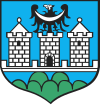Neogotycki ratusz z lat 1862-64, panorama miasta, Krzywa Wieża z XIV w.
gotycki most na Budzówce, ruiny renesansowego zamku z XVI w.
Pocztówkę przysłała mi moja mama.
Bardzo się zdziwiłam, gdyż była to dla mnie niespodzianka :-)
 Ząbkowice Śląskie (niem. Frankenstein) – miasto w woj. dolnośląskim.
Ząbkowice Śląskie (niem. Frankenstein) – miasto w woj. dolnośląskim.Niektóre źródła podają, iż nazwisko doktora Frankensteina z bohatera powieści Mary Shelley pt. Frankenstein ma pochodzić od nazwy miasta Ząbkowic Śląskich (ówczesna nazwa miasta to właśnie Frankenstein). Mieszkała tam rodzina prawdziwego doktora Frankensteina. Pisarka Mary Shelley miała spotkać go podczas swojej podróży po Europie i urzeczona nim postanowiła jego nazwisko nadać bohaterowi swojej powieści .
Ratusz - Obecny ratusz stanowi trzecią tego typu budowlę, postawioną w tym miejscu:
pierwszy ratusz – drewniany, powstał na początku XIVw., wkrótce po założeniu miasta,
drugi – renesansowy zbudowano w latach 1532 – 1534; istniał on do pożaru miasta w 1858,
trzeci – neogotycki postawiono w latach 1862 – 1864, wg projektu Alexisa Langera z Wrocławia.
pierwszy ratusz – drewniany, powstał na początku XIVw., wkrótce po założeniu miasta,
drugi – renesansowy zbudowano w latach 1532 – 1534; istniał on do pożaru miasta w 1858,
trzeci – neogotycki postawiono w latach 1862 – 1864, wg projektu Alexisa Langera z Wrocławia.
Krzywa wieża - średniowieczna krzywa wieża jest jedną z ciekawostek turystycznych Dolnego Śląska. Wysokość tej wieży wynosi 34 m, a jej obecne odchylenie od pionu 2,14 m.
Zamek – renesansowa budowla wzniesiona w latach 1522–1532 na miejscu gotyckiego zamku obronnego, obecnie w ruinie.
Ząbkowice Śląskie (German: Frankenstein in Schlesien) is a town in Lower Silesian Voivodeship in south-western Poland. It is the seat of Ząbkowice Śląskie County, and of the smaller administrative district (gmina) called Gmina Ząbkowice Śląskie. The town lies approximately 63 kilometres (39 mi) south of the regional capital Wrocław. As at 2006, it has a population of 16,242.
The town was established by Duke of Silesia Henry IV Probus as Frankenstein in the early 13th century, following the Mongol invasion. It was sited on a piece of land that belonged partly to the episcopal lands of Procan (German Protzan, modern Zwrócona) and partly to the Monastery at Trzebnica (German Trebnitz). The town was located exactly halfways between the sites of two previously existing towns that had failed to attract enough settlers: Frankenberg and Löwenstein, and inherited its' German name from both.
The town was established by Duke of Silesia Henry IV Probus as Frankenstein in the early 13th century, following the Mongol invasion. It was sited on a piece of land that belonged partly to the episcopal lands of Procan (German Protzan, modern Zwrócona) and partly to the Monastery at Trzebnica (German Trebnitz). The town was located exactly halfways between the sites of two previously existing towns that had failed to attract enough settlers: Frankenberg and Löwenstein, and inherited its' German name from both.
Its' positioning on the so called Königstraße (King's Road) between Prague and Breslau, not too far from the commercially important city of Glatz would favour the development of the town. The town received municipal rights around 1280, the first mention of civitas Frankenstein is dated January 10, 1287. As from 1335 it belonged to Bohemia, and from 1742 to Prussia.
In the early 17th century the plague killed about one third of the population, and it has been speculated that events at that time may have inspired the Frankenstein story.
In 1858 the town burned down and had to be rebuilt. On this occasion, the upper part of the 15th-century leaning tower was reconstructed in a straight manner. The town was a county seat from 1816 to 1945. After World War II the town passed to Poland (along with most of Silesia) and was renamed Ząbkowice Śląskie in 1946, after the German population had fled or been expelled.
In 1858 the town burned down and had to be rebuilt. On this occasion, the upper part of the 15th-century leaning tower was reconstructed in a straight manner. The town was a county seat from 1816 to 1945. After World War II the town passed to Poland (along with most of Silesia) and was renamed Ząbkowice Śląskie in 1946, after the German population had fled or been expelled.
Bardzo podoba mi się seria z literkami.
Chciałabym mieć cały alfabet :-)
Chciałabym mieć cały alfabet :-)



No comments:
Post a Comment